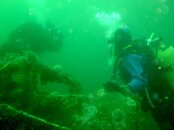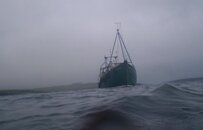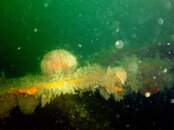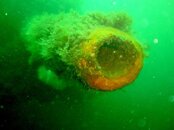Tjack
Contributor
- Messages
- 998
- Reaction score
- 191
- # of dives
- 500 - 999
Scapa Flow Dive Notes July 2013
The Scapa Flow is legendary amongst wreck diving locations, so on a recent family trip to Scotland I decided to check it out. Here is some info.
Scapa Flow is a large body of water surrounded by the Orkney Islands off the northern tip of Scotland. What makes it famous for wreck diving is that at the end of WW1 the German high seas fleet was interned there as part of an armistice between Germany and England. While negotiations were underway as to what would be the fate of the german fleet the German commander decided not to let his ships fall into the hands of the allies so on June 21 1919 he gave the order to scuttle the whole fleet.

This dastardly deed provided divers with the highest concentration of WW1 German warships anywhere. Three battleships and four cruisers remain after extensive salvage efforts. Some salvage was also conducted on these remaining ships, large holes were blasted into them to recover non ferrous metals but they remain largely intact. The battleships being top heavy with massive guns all turtled while sinking but the cruisers lay on there sides.
Most diving is based out of Stromness, Mainland Orkney, For the average traveler full rentals, including locally made 7 mm Neoprene dry suits are available from Scuba Scapa. Scuba Scapa is the only full service PADI shop which offers guided dives to the Flow. They get fully booked up so contact them well in advance. When I was planning my trip they initially told me they were fully booked for the summer months but fortunately they had space open up about two weeks out from my trip. Other wise my option would have been to go out with Andy Cuthbert who runs Scapa Flow Charters. Andy offered me space on one of his day boats but could not guarantee I would have a buddy for the dives.
Several charter boats will take you out to the wrecks but these are usually booked well in advance by dive clubs from around the UK. It is my impression that most of these clubs dive deco profiles with twin sets or pony bottles at a minimum. If you are tech certified they might take you along, worth contacting them to see. Some of the boats offer live aboard accommodations, but from what I saw this would be pretty primitive bunk room berths. The live aboards tend to moor up in Stromness each night so a pub would be at hand for pints and bites.

Considering the conditions I was glad to go guided with Scuba Scapa which cost 145 british pounds and included charter, full gear rental and excellent guides. We had 2 divers plus a DM Alex and an instructor Theresa who was kitted out with twin set and a canister light. My fellow client from Australia had just finished a dry suit course the day before.
Most dives on the WW1 German fleet run 100’ deep or more so deco is a real consideration. We did a 33 minute dive to 101’ on the SMS Dresden and were right at the edge of deco. The Dresden is one of the least demanding of the WW1 German wrecks. With cold murky water and variable currents the WW1 German wrecks are suitable for advanced divers only. There are shallower wrecks which were used to block the entrances to the Flow, but the German fleet is the real draw here.

As a warm up dive we dove the Churchill Barrier #3 block ships on day one. These shallow wrecks provide a great gear orientation, especially with an unfamiliar dry suit, allowing us to get our weighting dialed in for the deeper dives the following day. Abundant kelp and fish make for interesting diving amongst these broken up wrecks which bottom out at around 30’ Numerous nudibranchs and sea hares were on the wreckage and some fun swim throughs were explored. These were two guided shore dives which cost 120 british pounds with transport, gear rental and guides, bring your own lunch.
Day two we boarded the Jean Elaine, a converted work boat captained by Andy Cuthbert, to dive the SMS Dresden German light cruiser, at 500’ long we were only able to dive the bow section and conning tower. One large gun is present there as well. Descending on the mooring line into the green gloom was a trip and as we approached the wreck a faint outline of the prow appeared. Reconnoitering the bow section was all we had time for so we head back up the line, hanging at 15’ multiple jellyfish cruised by in the light swirling current. On the surface we are approached by the dive boat which has a lift or elevator to bring you back up on deck, that was a first for me. What a thrill to finally dive one of the famous WW1 wrecks of the infamous Scpa Flow!

Our second dive of the daily was the F2, a German torpedo recovery ship from WW2, this wreck lies in 55’ feet of water which allows for a longer dive with better light. Here we found lots of life, Conger Eels and Cuckoo Wrasse which look like something out of the tropics. Lots of swim throughs and a great gun turret make this an excellent second dive.
Overall the diving is what it is, cold and murky on some great wrecks.
The history of the German High seas fleet of WW1 is the big draw here and these massive wrecks provide an excellent challenge. There is likewise a good abundance of life on the wrecks with schooling fish, plumbious anemones and sea stars galore.
The real bonus of the trip was visiting the Orkney Islands, one gets a sense of being at the ends of the earth here. The ferry ride from Scrabster to Stromness takes you past the Old Man of Hoy, a spectacular spire of rock surrounded with Puffins and other exotic sea birds. Orkney is a truly magical place with it’s mists and abundant lighthouses, adding to the ambiance, the islands are covered in neolithic ruins and stone circles akin to Stone Henge . Scotland overall is a very hospitable place with some of the friendliest people you can meet. If you are looking for a different kind of dive trip and you have the skills, Scapa Flow is a real adventure.
I welcome questions or comments, T
Here are some photos.....
http://www.scubaboard.com/gallery/showgallery.php?cat=6014
The Scapa Flow is legendary amongst wreck diving locations, so on a recent family trip to Scotland I decided to check it out. Here is some info.
Scapa Flow is a large body of water surrounded by the Orkney Islands off the northern tip of Scotland. What makes it famous for wreck diving is that at the end of WW1 the German high seas fleet was interned there as part of an armistice between Germany and England. While negotiations were underway as to what would be the fate of the german fleet the German commander decided not to let his ships fall into the hands of the allies so on June 21 1919 he gave the order to scuttle the whole fleet.

This dastardly deed provided divers with the highest concentration of WW1 German warships anywhere. Three battleships and four cruisers remain after extensive salvage efforts. Some salvage was also conducted on these remaining ships, large holes were blasted into them to recover non ferrous metals but they remain largely intact. The battleships being top heavy with massive guns all turtled while sinking but the cruisers lay on there sides.
Most diving is based out of Stromness, Mainland Orkney, For the average traveler full rentals, including locally made 7 mm Neoprene dry suits are available from Scuba Scapa. Scuba Scapa is the only full service PADI shop which offers guided dives to the Flow. They get fully booked up so contact them well in advance. When I was planning my trip they initially told me they were fully booked for the summer months but fortunately they had space open up about two weeks out from my trip. Other wise my option would have been to go out with Andy Cuthbert who runs Scapa Flow Charters. Andy offered me space on one of his day boats but could not guarantee I would have a buddy for the dives.
Several charter boats will take you out to the wrecks but these are usually booked well in advance by dive clubs from around the UK. It is my impression that most of these clubs dive deco profiles with twin sets or pony bottles at a minimum. If you are tech certified they might take you along, worth contacting them to see. Some of the boats offer live aboard accommodations, but from what I saw this would be pretty primitive bunk room berths. The live aboards tend to moor up in Stromness each night so a pub would be at hand for pints and bites.

Considering the conditions I was glad to go guided with Scuba Scapa which cost 145 british pounds and included charter, full gear rental and excellent guides. We had 2 divers plus a DM Alex and an instructor Theresa who was kitted out with twin set and a canister light. My fellow client from Australia had just finished a dry suit course the day before.
Most dives on the WW1 German fleet run 100’ deep or more so deco is a real consideration. We did a 33 minute dive to 101’ on the SMS Dresden and were right at the edge of deco. The Dresden is one of the least demanding of the WW1 German wrecks. With cold murky water and variable currents the WW1 German wrecks are suitable for advanced divers only. There are shallower wrecks which were used to block the entrances to the Flow, but the German fleet is the real draw here.

As a warm up dive we dove the Churchill Barrier #3 block ships on day one. These shallow wrecks provide a great gear orientation, especially with an unfamiliar dry suit, allowing us to get our weighting dialed in for the deeper dives the following day. Abundant kelp and fish make for interesting diving amongst these broken up wrecks which bottom out at around 30’ Numerous nudibranchs and sea hares were on the wreckage and some fun swim throughs were explored. These were two guided shore dives which cost 120 british pounds with transport, gear rental and guides, bring your own lunch.
Day two we boarded the Jean Elaine, a converted work boat captained by Andy Cuthbert, to dive the SMS Dresden German light cruiser, at 500’ long we were only able to dive the bow section and conning tower. One large gun is present there as well. Descending on the mooring line into the green gloom was a trip and as we approached the wreck a faint outline of the prow appeared. Reconnoitering the bow section was all we had time for so we head back up the line, hanging at 15’ multiple jellyfish cruised by in the light swirling current. On the surface we are approached by the dive boat which has a lift or elevator to bring you back up on deck, that was a first for me. What a thrill to finally dive one of the famous WW1 wrecks of the infamous Scpa Flow!

Our second dive of the daily was the F2, a German torpedo recovery ship from WW2, this wreck lies in 55’ feet of water which allows for a longer dive with better light. Here we found lots of life, Conger Eels and Cuckoo Wrasse which look like something out of the tropics. Lots of swim throughs and a great gun turret make this an excellent second dive.
Overall the diving is what it is, cold and murky on some great wrecks.
The history of the German High seas fleet of WW1 is the big draw here and these massive wrecks provide an excellent challenge. There is likewise a good abundance of life on the wrecks with schooling fish, plumbious anemones and sea stars galore.
The real bonus of the trip was visiting the Orkney Islands, one gets a sense of being at the ends of the earth here. The ferry ride from Scrabster to Stromness takes you past the Old Man of Hoy, a spectacular spire of rock surrounded with Puffins and other exotic sea birds. Orkney is a truly magical place with it’s mists and abundant lighthouses, adding to the ambiance, the islands are covered in neolithic ruins and stone circles akin to Stone Henge . Scotland overall is a very hospitable place with some of the friendliest people you can meet. If you are looking for a different kind of dive trip and you have the skills, Scapa Flow is a real adventure.
I welcome questions or comments, T
Here are some photos.....
http://www.scubaboard.com/gallery/showgallery.php?cat=6014




